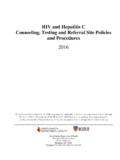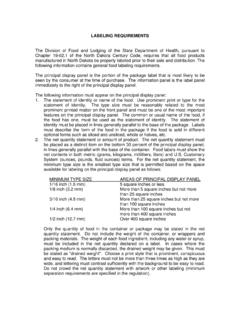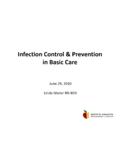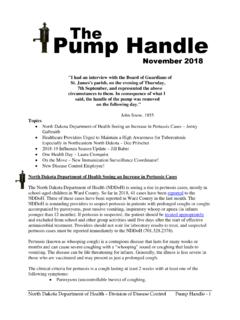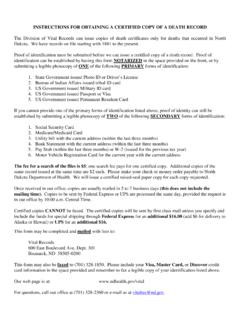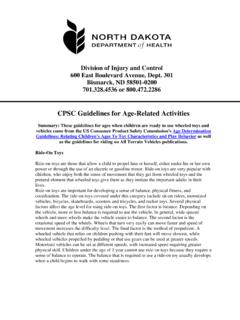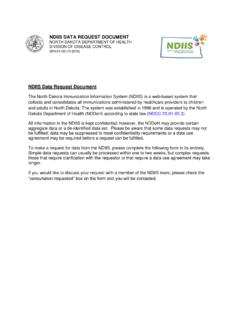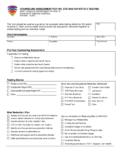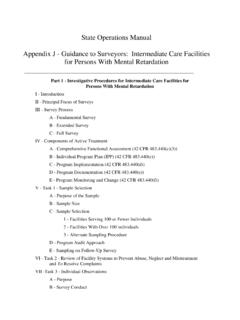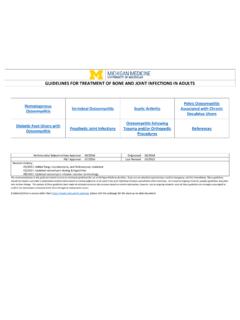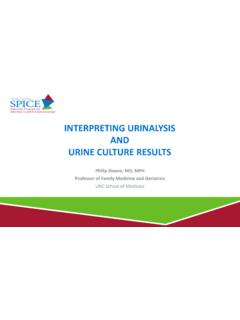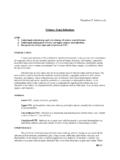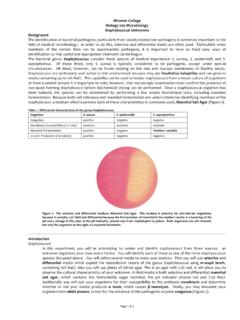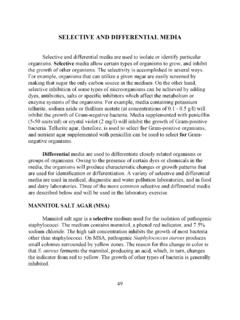Transcription of Laboratory Methods for Detection of Methicillin-Resistant ...
1 Appendix F Laboratory Methods for Detection of Methicillin-Resistant Staphylococcus Aureus (MRSA) In the , most strains of Staphylococcus aureus are resistant to penicillin due to the production of the enzyme beta lactamase and, until the 1960s, were uniformly susceptible to beta-lactamase stable penicillins, such as methicillin and oxacillin. Resistance to antistaphylococcal beta-lactamase stable penicillins has been historically referred to as Methicillin-Resistant Staphylococcus aureus or MRSA. The acronym MRSA is still commonly used even though methicillin is no longer used for treatment. Antimicrobials like oxacillin and nafcillin now are used for treatment of Staphylococcus aureus infections. The acronym ORSA (oxacillin-resistant Staphylococcus aureus) may be used interchangeably with MRSA. Accurate Detection of MRSA can be difficult because susceptible and resistant populations may coexist in the same culture. This heteroresistance is a problem in the clinical Laboratory because the resistant population may grow more slowly than the susceptible population.
2 The National Committee for Clinical Laboratory Standards (NCCLS) recommends the following for accurate Detection of oxacillin/methicillin MIC Susceptibility Method 1. Direct Colony Inoculum Isolated colonies from an 18 to 24 hour nonselective agar plate are used to prepare a direct inoculum equivalent to a McFarland Standard. 2. Oxacillin is the preferred agent for Detection of methicillin resistance. 3. Supplementation of Test Medium The addition of 2% NaCl to broth dilution is recommended to enhance Detection of MRSA. Commercial susceptibility systems supplement with NaCl. 4. Incubation Time and Temperature Tests must be incubated for a FULL 24 hours at 35 C. Incubation temperature must not exceed 35 C. 5. Interpretation of Results Oxacillin-Susceptible Oxacillin-Resistant Staphylococcus aureus MIC <2 ug/ml > 4ug/ml IMPORTANT: Oxacillin/methicillin resistance implies resistance to all penicillins, cephems, imipenem and beta lactam/beta lactamase inhibitor combinations such as ampicillin/sulbactam, amoxacillin/clavulanic acid, piperacillin/tazobactam, and ticarcillin,/clavulanic acid regardless of the in vitro test results.
3 This is because most cases of documented MRSA infections have responded poorly to beta lactam therapy or 36because convincing clinical data have yet to be presented to document clinical efficacy. These antimicrobial agents MUST be reported as RESISTANT. DISK DIFFUSION SUSCEPTIBILITY METHOD 1. Direct colony inoculum preparation 2. Mueller Hinton agar 3. 1 ug oxacillin disk 4. Incubate for a FULL 24 hrs at 35 C. 5. Interpretation of results Resistant (MRSA): < 10 mm zone size of inhibition Confirm with Oxacillin Screening Agar: 11-12 mm zone size of inhibition Susceptible (No MRSA) > 13 mm zone size of inhibition OXACILLIN AGAR SCREENING TEST When performed correctly, both disk diffusion and MIC tests accurately detect MRSA. The oxacillin screening plate can be used in addition to or as a backup method. 1. Mueller Hinton agar with 4% NaCl and 6 ug/ml of Oxacillin 2. Direct colony inoculum preparation Dip swab into inoculum, express excess fluid and streak quadrant of the agar or spot inoculate 1 to10 ul of the suspension to a quadrant of the plate.
4 3. Incubate full 24 hours at 35 C. 4. > 1 colony or light film of growth = oxacillin/ Methicillin-Resistant INCORRECT IDENTIFICATION OF MRSA 1. Mixed culture Methicillin-Resistant coagulase negative staphylococcus mixed with a methicillin-susceptible Staphylococcus aureus. It is advisable to perform a purity check of the inoculum suspension each time a susceptibility test is performed. This plate should be examined for the presence of a second organism. Isolate and retest if indicated. 2. Misidentification Rarely, a coagulase negative staphylococcus may give a false positive reaction with commercially available slide agglutination Methods . A test tube coagulase test may be indicated in select situations to confirm an identification of Staphylococcus aureus. ADDITIONAL TESTS TO DETECT MRSA 1. Amplification tests, like those based on polymerase chain reaction (PCR), are available to detect the mecA gene. 2. Latex agglutination Methods are available for Detection of the penicillin-binding protein 2a (PBP2a).
5 High level methicillin resistance in Staphylococcus aureus is dependent upon the acquisition of the mec A gene encoding PBP2a. This protein is involved in the assembly of the cell wall in bacteria and is poorly inactivated by beta-lactam antibiotics. 37 Vancomycin-Intermediate Staphylococcus Aureus (VISA) The first occurrence of Staphylococcus aureus strains with reduced susceptibility to vancomycin (MIC 4-8 ug/ml) was reported from Japan in 1997, followed by reports from the and other countries. All strains of Staphylococcus aureus with vancomycin MIC of > to 4ug/ml should be considered candidate strains for VISA. 1. Disk diffusion is not an acceptable method for vancomycin susceptibility testing of Staphylococcus aureus. CDC indicates none of the known strains of Staphylococcus aureus with reduced susceptibility to vancomycin have been detected by this method. 2. An MIC method or Epsilometer test (E test) (AB Biodisk, Solna, Sweden) should be used.
6 3. Test must be incubated for a full 24 hours before reading. The vancomycin agar screen test used for enterococci may also be used to detect VISA. 4. The Laboratory should ensure the strain is a pure culture. Repeat the test for confirmation. Immediately contact the infection control department and contact the state health department. Vancomycin Resistant Staph Auueus (VRSA) The first occurrence of VRSA in the was isolated in Michigan in July 2002. Refer to the guidelines for VISA. Emerging Resistance To Staphylococcus For guidelines for emerging resistance to Staphylococcus and other microorganisms, consult the current NCCLS M100 document issued in January of each year. References: 1. NCCLS M7-A6. Methods for Dilution Antimicrobial Susceptibility Tests for Bacteria That Grow Aerobically. 2. NCCLS M100-S13. Performance Standards for Antimicrobial Susceptibility Testing. Thirteenth Informational Supplement. 3. MMWR January 7, 2000 51 &52.
7 Laboratory Capacity to Detect Antimicrobial Resistance1998. Recommendations for Testing for Staphylococcus Aureus with Reduced Susceptibility to Vancomycin. 4. Draft: Health System Response to Control the First Sentinel Case of VRSA. 38 Laboratory Methods For Detection of Vancomycin Resistant Enterococci (VRE) Recommendations of the Hospital Infection Control Practices Advisory Committee1 Role of the microbiology Laboratory in the Detection , reporting and control of VRE The microbiology Laboratory is the first line of defense against the spread of VRE in the hospital. The Laboratory s ability to identify enterococci and detect vancomycin resistance promptly and accurately is essential in recognizing VRE colonization and infection and avoiding complex, costly containment efforts that are required when recognition of the problem is delayed. In addition, cooperation and communication between the Laboratory and the infection control program will facilitate control efforts substantially.
8 Identification of Enterococci Presumptively identify colonies on primary isolation plates as enterococci by using the colonial morphology, Gram stain, and pyrrolidonyl arylamidase (PYR) test. Although identifying enterococci to the species level can help predict certain resistance patterns ( , Enterococcus faecium is more resistant to penicillin than is Enterococcus faecalis) and may help determine the epidemiologic relatedness of enterococcal isolates, such identification is not routinely necessary if antimicrobial susceptibility testing is performed. However, under special circumstances or as Laboratory resources permit, biochemical tests can be used to differentiate between various enterococcal species. Most commercially available identification systems adequately differentiate Enterococcus faecalis from other species of enterococci. However, additional tests for motility and pigment production are required to distinguish Enterococcus gallinarum (motile and nonpigmented) and Enterococcus casseliflavus (motile and pigmented) and Enterococcus faecium (nonmotile and nonpigmented).
9 Tests for Antimicrobial Susceptibility All enterococcal isolates should be tested for susceptibility to penicillin, ampicillin and vancomycin and other drugs as clinically indicated. Determination of actual MIC for blood and CSF should be considered. Vancomycin Resistance Although different test Methods can be used, it is critical that all laboratories use the same interpretive standards for determining vancomycin resistance. Since breakpoints for disk diffusion or MIC susceptibility tests are periodically changed by the National Committee for Clinical Laboratory Standards (NCCLS), these documents should be reviewed The 2004 NCCLS breakpoints for determining vancomycin resistance by disk diffusion (30 g) are: susceptible ( 17 mm), intermediate (15-16 mm) and resistant ( 14 mm). For dilution testing, the 2003 breakpoints are susceptible ( 4 g/mL), intermediate (8-16 g/mL), and resistant ( 32 g/mL).2 Accurate Detection of vancomycin-resistant enterococci by the agar or broth dilution test requires incubation for a full 24 hours (rather than 16 to 20 hours).
10 The plates, tubes, or 39wells must be examined carefully for evidence of faint growth. A vancomycin screen agar, containing 6 g/mL of vancomycin, also may be used. However, it cannot differentiate between intermediate or high level resistance. The MIC test is recommended for confirmation of vancomycin resistance isolates. Speciation of enterococcus should be done whenever possible. Disk Diffusion Although this method has been shown to be unreliable for detecting resistance in strains with intermediate or low-level resistance to vancomycin, it remains an acceptable alternative for those laboratories not routinely performing MIC tests. A disk content of 30 g should be used. Plates should be read using transmitted light rather than reflected light, since some vancomycin-resistant strains produce hazy growth with a larger zone of inhibition. In addition, disk diffusion plates should be incubated for a full 24 hours.
